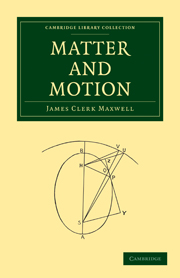Book contents
CHAPTER VIII - UNIVERSAL GRAVITATION
Published online by Cambridge University Press: 05 October 2010
Summary
NEWTON'S METHOD
The most instructive example of the method of dynamical reasoning is that by which Newton determined the law of the force with which the heavenly bodies act on each other.
The process of dynamical reasoning consists in deducing from the successive configurations of the heavenly bodies, as observed by astronomers, their velocities and their accelerations, and in this way determining the direction and the relative magnitude of the force which acts on them.
Kepler had already prepared the way for Newton's investigation by deducing from a careful study of the observations of Tycho Brahe the three laws of planetary motion which bear his name.
KEPLER'S LAWS
Kepler's Laws are purely kinematical. They completely describe the motion of the planets, but they say nothing about the forces by which these motions are determined.
Their dynamical interpretation was discovered by Newton.
The first and second law relate to the motion of a single planet.
Law I.—The areas swept out by the vector drawn from the sun to a planet are proportional to the times of describing them. If h denotes twice the area swept out in unit of time, twice the area swept out in time t will be h t, and if P is the mass of the planet, P h t will be the mass-area, as defined in Article LXVIII.
Information
- Type
- Chapter
- Information
- Matter and Motion , pp. 107 - 125Publisher: Cambridge University PressPrint publication year: 2010First published in: 1888
